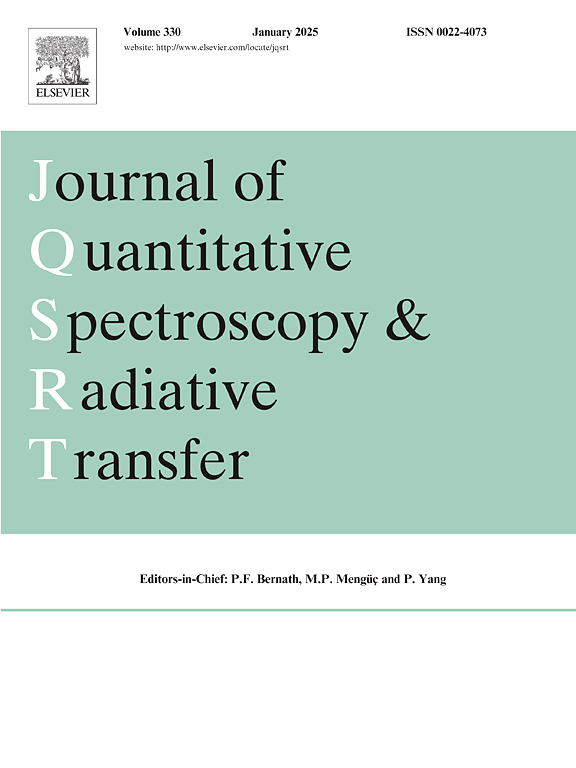Assignment and modeling of 13CH4 spectrum at 298 K in the lower part of the Tetradecad in the 4970–5300 cm−1 range
IF 2.3
3区 物理与天体物理
Q2 OPTICS
Journal of Quantitative Spectroscopy & Radiative Transfer
Pub Date : 2024-09-12
DOI:10.1016/j.jqsrt.2024.109196
引用次数: 0
Abstract
The absorption spectrum of the 13CH4 methane isotopologue was recorded on a Bruker IFS-125HR Fourier transform spectrometer at 298 K in the 4970–6200 cm−1 range. In this paper we report the results of assignment and modelling of the line positions and intensities of 13CH4 in the range of weaker absorption between 4970 and 5300 cm−1, corresponding to the lower part of Tetradecad, dominated by the 4ν4 band system near 5180 cm−1. The empirical list in this spectral range contains 1642 lines. Using an effective Hamiltonian initially derived from the analyses of cold Fourier transform (4970–5853 cm−1) and laser direct absorption (5853–6200 cm−1) spectra of the 13CH4, we assigned 1600 lines belonging to four bands of the Tetradecad up to Jmax=16. The 1548 line positions were fitted with an rms deviation of 1.7 × 10−3 cm−1. Measured line intensities were modeled for 674 transitions using the effective dipole transition moments to an rms deviation of about 7 %. The new data were used for the simultaneous global fit of the 13CH4 Hamiltonian parameters for the {Ground state / Dyad / Pentad / Octad / Tetradecad} system and the dipole moment parameters for the {Ground state - Tetradecad} system.
298 K 时四分频谱下部 4970-5300 cm-1 范围内 13CH4 光谱的赋值与建模
布鲁克 IFS-125HR 傅立叶变换光谱仪在 298 K 温度下记录了 13CH4 甲烷同素异形体在 4970-6200 cm-1 范围内的吸收光谱。在本文中,我们报告了对 4970 至 5300 cm-1 之间较弱吸收范围内 13CH4 的谱线位置和强度进行赋值和建模的结果,该范围对应于 Tetradecad 的下半部分,以 5180 cm-1 附近的 4ν4 波段系统为主。该光谱范围内的经验列表包含 1642 条光谱线。通过对 13CH4 的冷傅立叶变换(4970-5853 cm-1)和激光直接吸收(5853-6200 cm-1)光谱的分析,我们初步得出了有效哈密顿方程,并利用该方程分配了 1600 条属于 Tetradecad 的四个波段(最高 Jmax=16)的谱线。1548 条线的位置拟合均方根偏差为 1.7 × 10-3 cm-1。利用有效偶极转换矩为 674 个转换建立了测量到的线强度模型,均方根偏差约为 7%。新数据用于同时对{基态/二元/五元/八元/十元四元}系统的 13CH4 哈密顿参数和{基态-十元四元}系统的偶极矩参数进行全局拟合。
本文章由计算机程序翻译,如有差异,请以英文原文为准。
求助全文
约1分钟内获得全文
求助全文
来源期刊
CiteScore
5.30
自引率
21.70%
发文量
273
审稿时长
58 days
期刊介绍:
Papers with the following subject areas are suitable for publication in the Journal of Quantitative Spectroscopy and Radiative Transfer:
- Theoretical and experimental aspects of the spectra of atoms, molecules, ions, and plasmas.
- Spectral lineshape studies including models and computational algorithms.
- Atmospheric spectroscopy.
- Theoretical and experimental aspects of light scattering.
- Application of light scattering in particle characterization and remote sensing.
- Application of light scattering in biological sciences and medicine.
- Radiative transfer in absorbing, emitting, and scattering media.
- Radiative transfer in stochastic media.

 求助内容:
求助内容: 应助结果提醒方式:
应助结果提醒方式:


